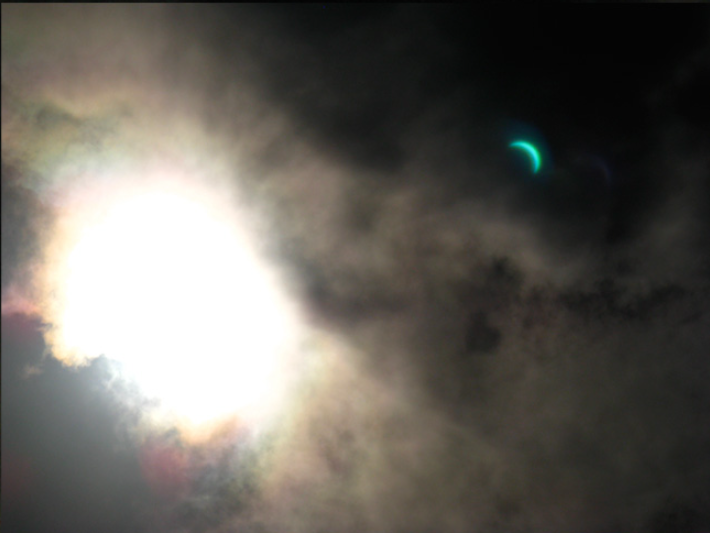Unwelcome Optics?
Unwelcome Optics? Exploring the Fascinating World of Atmospheric Phenomena
Have you ever experienced an eclipse and found yourself captivated by the breathtaking beauty of the celestial event, only to be surprised by the appearance of unexpected optical effects in the sky? Well, you're not alone. In this article, we delve into the intriguing realm of atmospheric optics and uncover some fascinating phenomena that can accompany eclipses and other celestial events.
One of these captivating optical effects is known as eclipse iridescence. Picture this: you've meticulously planned your eclipse viewing, traveled countless miles, and eagerly await the moment when the moon aligns perfectly with the sun. As the partial phase of the eclipse begins, you notice thin clouds in the sky, seemingly infused with a mesmerizing display of iridescent colors. These ethereal hues emerge as the tiny droplets within the clouds diffract the light of the crescent sun. It's a sight that both enchants and bewilders observers.
Another noteworthy phenomenon is the appearance of a green sun during an eclipse. While it may seem perplexing at first, rest assured that the "real" sun is still shining brightly somewhere within the overexposed region of the sky. In fact, this unique occurrence offers a rare opportunity to observe the sun's shape using a lens reflection. By capturing this elusive moment, photographers like Robert Goren have provided us with captivating images that showcase the sun's true form amidst a sea of vibrant green.
But what exactly causes these enchanting optical effects during an eclipse? The answer lies in the intricate interplay between light and atmospheric particles. As sunlight passes through the Earth's atmosphere, it encounters various types of particles, such as dust, water droplets, and ice crystals. These particles can scatter and refract light, giving rise to a multitude of captivating phenomena that often surprise and captivate observers.
Eclipse iridescence, for instance, occurs when the tiny droplets within thin clouds diffract sunlight, causing it to disperse into its component colors. This phenomenon is similar to the iridescent colors seen in soap bubbles or oil slicks on water. The delicate interplay between the size and arrangement of these droplets determines the specific hues that grace the sky during an eclipse, creating a truly magical experience for those fortunate enough to witness it.
As for the green sun phenomenon, it can be attributed to a combination of atmospheric scattering and the eye's sensitivity to different wavelengths of light. During an eclipse, the Earth's atmosphere scatters shorter wavelengths of light (such as blue and green) more than longer wavelengths (such as red and orange). This preferential scattering of shorter wavelengths can lead to a temporary dominance of green light in the sky, resulting in the intriguing appearance of a green sun.
The world of atmospheric optics is not limited to eclipses alone. Various other celestial events, such as sunsets, rainbows, and halos, also offer glimpses into this captivating realm. Each phenomenon arises from a unique set of conditions and interactions between light and atmospheric particles, resulting in a dazzling array of colors and patterns that continue to amaze scientists and enthusiasts alike.
In conclusion, while unexpected optical effects during celestial events may initially catch us off guard, they ultimately provide us with an opportunity to witness the sheer beauty and complexity of our atmosphere. Whether it's the enchanting iridescence of clouds during an eclipse or the awe-inspiring colors of a sunset, these atmospheric phenomena serve as a reminder of the intricate interplay between light and matter that surrounds us every day. So, next time you find yourself gazing at the sky during a celestial event, embrace the unexpected and let the wonders of atmospheric optics mesmerize you.

Eclipse Iridescence - When you have planned an eclipse viewing for years and traveled thousands of miles, an accompaniment of sky optical effects is not wholly welcome.
Robert Goren took these shots from south of Tahiti during the partial phase of last Sunday's total eclipse.
The thin clouds are suffused with iridescent colours as their small droplets diffract the light of the crescent sun.
Green sun? The 'real' sun is somewhere in the bright overexposed region. This is one time when a lens reflection is really useful to show the sun's shape. ©Robert Goren, shown with permission.

Note: this article has been automatically converted from the old site and may not appear as intended. You can find the original article here.
Reference Atmospheric Optics
If you use any of the definitions, information, or data presented on Atmospheric Optics, please copy the link or reference below to properly credit us as the reference source. Thank you!
-
<a href="https://atoptics.co.uk/blog/unwelcome-optics/">Unwelcome Optics?</a>
-
"Unwelcome Optics?". Atmospheric Optics. Accessed on November 27, 2024. https://atoptics.co.uk/blog/unwelcome-optics/.
-
"Unwelcome Optics?". Atmospheric Optics, https://atoptics.co.uk/blog/unwelcome-optics/. Accessed 27 November, 2024
-
Unwelcome Optics?. Atmospheric Optics. Retrieved from https://atoptics.co.uk/blog/unwelcome-optics/.